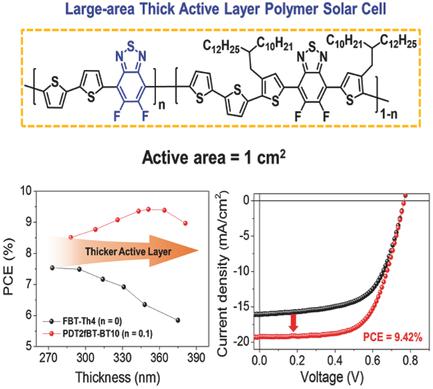当前位置:
X-MOL 学术
›
Adv. Energy Mater.
›
论文详情
Our official English website, www.x-mol.net, welcomes your feedback! (Note: you will need to create a separate account there.)
High‐Performance and Uniform 1 cm2 Polymer Solar Cells with D1‐A‐D2‐A‐Type Random Terpolymers
Advanced Energy Materials ( IF 27.8 ) Pub Date : 2017-11-27 , DOI: 10.1002/aenm.201701405 Injeong Shin 1, 2 , Hyung ju Ahn 3 , Jae Hoon Yun 1, 4 , Jea Woong Jo 1 , Sungmin Park 1 , Sung-yoon Joe 1 , Joona Bang 2 , Hae Jung Son 1, 4
Advanced Energy Materials ( IF 27.8 ) Pub Date : 2017-11-27 , DOI: 10.1002/aenm.201701405 Injeong Shin 1, 2 , Hyung ju Ahn 3 , Jae Hoon Yun 1, 4 , Jea Woong Jo 1 , Sungmin Park 1 , Sung-yoon Joe 1 , Joona Bang 2 , Hae Jung Son 1, 4
Affiliation

|
For the commercial development of organic photovoltaics (OPVs), laboratory‐scale OPV technology must be translated to large area modules. In particular, it is important to develop high‐efficiency polymers that can form thick (>100 nm) bulk heterojunction (BHJ) films over large areas with optimal morphologies for charge generation and transport. Here, D1‐A‐D2‐A random terpolymers composed of 2,2′‐bithiophene with various proportions of 5,6‐difluoro‐4,7‐bis(thiophen‐2‐yl)‐2,1,3‐benzothiadiazole and 5,6‐difluoro‐2,1,3‐benzothiadiazole (FBT) are synthesized. It is found that incorporating small proportions of FBT into the polymer not only conserves the high crystallinity and favorable face‐on orientation of the D‐A copolymer FBT‐Th4 but also improves the nanoscale phase separation of the BHJ film. Consequently, the random terpolymer PDT2fBT‐BT10 exhibits a much improved solar cell efficiency of 10.31% when compared to that of the copolymer FBT‐Th4 (8.62%). Moreover, due to this polymer's excellent processability and suppressed overaggregation, OPVs with 1 cm2 active area based on 351 nm thick PDT2fBT‐BT10 BHJs exhibit high photovoltaic performance of 9.42%, whereas rapid efficiency decreases arise for FBT‐Th4‐based OPVs for film thicknesses above 300 nm. It is demonstrated that this random terpolymer can be used in large area and thick BHJ OPVs, and guidelines for developing polymers that are suitable for large‐scale printing technologies are presented.
中文翻译:

具有D1-A-D2-A-类型无规三元共聚物的高性能且均匀的1 cm2聚合物太阳能电池
对于有机光伏(OPV)的商业开发,必须将实验室规模的OPV技术转换为大面积模块。特别重要的是,开发能在大面积上形成厚(> 100 nm)的块状异质结(BHJ)膜且具有最佳形态的电荷产生和传输的高效聚合物。在这里,D 1 -A-D 2‐由2,2'-联噻吩和不同比例的5,6-二氟-4,7-双(噻吩-2-基)-2,1,3-苯并噻二唑和5,6-二氟-2组成的无规三元共聚物合成了1,1,3-苯并噻二唑(FBT)。发现将少量的FBT掺入聚合物中不仅保留了D-A共聚物FBT-Th4的高结晶度和良好的正面取向,而且还改善了BHJ膜的纳米级相分离。因此,与共聚物FBT-Th4(8.62%)相比,无规三元共聚物PDT2fBT-BT10的太阳能电池效率提高了10.31%。此外,由于该聚合物的优异加工性能和抑制的过度聚集,因此具有1 cm 2的OPV基于351 nm厚的PDT2fBT‐BT10 BHJ的有源区域表现出9.42%的高光电性能,而对于膜厚超过300 nm的基于FBT‐Th4的OPV,效率迅速下降。结果表明,这种无规三元共聚物可用于大面积和厚厚的BHJ OPV,并提出了开发适用于大规模印刷技术的聚合物的指南。
更新日期:2017-11-27
中文翻译:

具有D1-A-D2-A-类型无规三元共聚物的高性能且均匀的1 cm2聚合物太阳能电池
对于有机光伏(OPV)的商业开发,必须将实验室规模的OPV技术转换为大面积模块。特别重要的是,开发能在大面积上形成厚(> 100 nm)的块状异质结(BHJ)膜且具有最佳形态的电荷产生和传输的高效聚合物。在这里,D 1 -A-D 2‐由2,2'-联噻吩和不同比例的5,6-二氟-4,7-双(噻吩-2-基)-2,1,3-苯并噻二唑和5,6-二氟-2组成的无规三元共聚物合成了1,1,3-苯并噻二唑(FBT)。发现将少量的FBT掺入聚合物中不仅保留了D-A共聚物FBT-Th4的高结晶度和良好的正面取向,而且还改善了BHJ膜的纳米级相分离。因此,与共聚物FBT-Th4(8.62%)相比,无规三元共聚物PDT2fBT-BT10的太阳能电池效率提高了10.31%。此外,由于该聚合物的优异加工性能和抑制的过度聚集,因此具有1 cm 2的OPV基于351 nm厚的PDT2fBT‐BT10 BHJ的有源区域表现出9.42%的高光电性能,而对于膜厚超过300 nm的基于FBT‐Th4的OPV,效率迅速下降。结果表明,这种无规三元共聚物可用于大面积和厚厚的BHJ OPV,并提出了开发适用于大规模印刷技术的聚合物的指南。


























 京公网安备 11010802027423号
京公网安备 11010802027423号